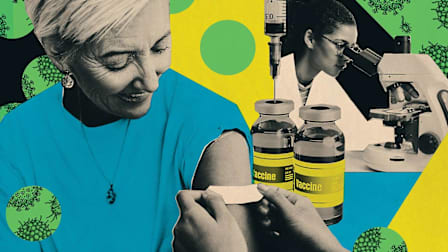Your Questions About Omicron, Answered
The highly contagious BA.2 subvariant of the omicron variant is the predominant form of the coronavirus around the world

Not long after it was first identified in South Africa in November of 2021, the highly contagious omicron variant of the coronavirus rapidly swept around the world.
By Dec. 25, omicron was responsible for 58.6 percent of COVID-19 cases in the U.S., according to the Centers for Disease Control and Prevention. Cases in the U.S. and many other countries skyrocketed to their highest levels, and now almost all cases in the u.s. are due to omicron.
In general, the omicron variant has been less likely to cause severe illness, according to the CDC. But it’s still capable of causing severe disease and death. Experts initially cautioned that a less severe but more contagious form of COVID-19 could still overwhelm hospitals—and the initial surge led to the highest peak in hospitalizations yet of the pandemic.
Some of the rapid spread has been attributed to the omicron variant’s ability to evade some of the protection against infection provided by vaccines, though they still provide some protection against infection and good protection against severe disease.
What's Unusual About the Omicron Variant?
Viruses like SARS-CoV-2 continually mutate as they replicate. Most of these small changes are inconsequential, and they are just as likely to make a virus less likely to transmit as they are to make it more so.
But sometimes a virus acquires a set of mutations that makes it more likely to spread. Increased transmissibility can make these variants—a word used to define a virus with a particular set of mutations—dominate in a certain region or even around the world, as happened with delta and subsequently with omicron. This can happen if the new variant creates a higher viral load, increasing the chances that contagious particles make it to another person. It can also happen if the new variant is better able to evade the immune system protection provided by prior infection or vaccination, which could help it spread among people who would otherwise be protected.
Omicron has far more changes to the spike protein—the portion of the virus that infects human cells—than any of the previous concerning variants, says Gregory Poland, MD, director of the Vaccine Research Group at the Mayo Clinic in Rochester, Minn. For example, the alpha variant had four mutations to the spike protein, delta had 10, and omicron has more than 30.
Some mutations can make a vaccine less able to fend off infections, or they can make the monoclonal antibodies often used to treat COVID-19 less effective, says Luis Ostrosky, MD, a professor of infectious diseases at the McGovern Medical School at UTHealth in Houston and a fellow of the Infectious Diseases Society of America. A virus could also mutate in ways that could lead to illnesses that tend to be more severe—or milder.
Some of omicron’s mutations are probably responsible for its rapid spread, either by making it more transmissible overall or by making it better at evading protection due to vaccination or prior infection.
We learned about this variant early because of how quickly South African scientists were able to identify it and notify the world, says Aaron Glatt, MD, chair of the department of medicine and chief of infectious diseases at Mount Sinai South Nassau in Hewlett, N.Y. This sort of early recognition “is critically important,” he says.
What Is the BA.2 Subvariant?
Variants like omicron and delta have particular sets of mutations that differentiate them from each other. But there are also different genetic lineages of each variant, which can be identified as subvariants.
The subvariant known as BA.2 has a lot in common with the first type of omicron to spread around the globe, officially known as BA.1, says Anna Durbin, MD, director of the Center for Immunization Research and a professor in the department of international health at the Johns Hopkins Bloomberg School of Public Health, who spoke at a Johns Hopkins press conference on March 24.
But BA.2 is even more contagious—about 50 percent more contagious than BA.1, or as contagious as chickenpox. Each person with BA.2 is likely to spread the virus to eight to 12 others, according to Gypsyamber D’Souza, PhD, a professor of epidemiology at Johns Hopkins Bloomberg, who spoke at the same press conference.
The spread of BA.2 has coincided with loosening rules about wearing masks and distancing in many places and has led to the highest rates of infection yet in countries in Europe and in parts of Asia. On March 22, the World Health Organization (WHO) said BA.2 was the predominant form of the coronavirus around the globe. By March 29, a majority of COVID-19 cases in the U.S. were due to BA.2, according to CDC data. With mask mandates lifted in much of the U.S., much of the country is experiencing a rise in cases linked to the subvariant.
“We expect BA.2 to lead to more cases,” D’Souza said. But she also said that between vaccination and prior infection, there is some hope that it won’t necessarily be a surge like the first omicron wave. “There is hope that with the population immunity we have that what is to come will not be as bad as what has come,” she said.
And there are always questions about how further mutations could potentially affect transmission. Researchers are tracking two subvariants of BA.2 that appear to be about 25 percent more contagious, the New York State Department of Health announced on April 13. Researchers are also tracking another subvariant that’s related to both BA.1 and BA.2, known as XE. This subvariant has appeared in the U.K., the U.S., Israel, and Thailand, and appears to be potentially more contagious as well. But it’s not yet clear whether or not any of these subvariants will gain a foothold or prove to truly spread more rapidly than BA.2.
Do Vaccines Protect Against Omicron?
Yes, especially against severe disease, but they don’t offer as much protection against infection as they did against previous variants—though boosters help.
Research indicates that the efficacy of the initial vaccines wanes over time, and that this may be especially true with omicron. When delta was the predominant variant, vaccines remained 76 percent effective against hospitalization more than six months after a second shot, according to a CDC study. Efficacy against hospitalization at that time fell to 57 percent once omicron became predominant, the study found. But two weeks after a booster, protection against hospitalization rose back to 90 percent.
While omicron is still more likely than previous variants to cause mild illness in vaccinated people, boosters help there, too. A study published in JAMA found that after a booster dose, people were 66 percent less likely to test positive for omicron than those who had just received the initial two vaccine doses.
Still, booster efficacy appears to start to wane after about four months as well. With a potential BA.2 rise in cases looming, both Moderna and Pfizer/BioNTech asked the Food and Drug Administration to authorize a second booster dose. So far, the agency has authorized an additional booster for Americans 50 and up.
Fortunately, BA.2 doesn’t seem to be any better than BA.1 at evading protection provided by vaccines, D’Souza says.
Is Omicron More Transmissible?
Yes. Variants of the coronavirus are labeled “variants of concern” if they appear to be more transmissible, if they cause more severe disease, or if they make vaccines, treatments, or diagnostic tests less effective. In the case of omicron, it’s the speedy spread of the variant—indicating potentially increased transmissibility—that raised the alarm and quickly caused WHO and CDC to declare it a variant of concern. Poland and other experts said initially that omicron appeared to be about twice as transmissible as delta.
The BA.2 subvariant is even more contagious, about 50 percent more likely to spread than even the original BA.1 version of omicron.
Does Omicron Cause More Severe Illness?
No. Generally speaking, omicron infections appear to be somewhat less severe, according to the CDC, though they can still lead to severe disease and death, especially in people who are unvaccinated. And these infections may only appear less severe in populations with high levels of vaccination or prior infection. Some preliminary research from Hong Kong indicates that in unvaccinated people, omicron has a similar fatality rate to the ancestral or original strain of the coronavirus.
The variant’s spread shows how a less severe but more transmissible form of a disease can still lead to higher numbers of severe cases and hospitalizations just due to the sheer number of overall infections.
This is perhaps especially notable in children, who were far more likely to become infected during omicron’s peak than during any previous surge. A CDC study of children under 5—who are not yet eligible for vaccination—released March 18 found that they were about five times as likely to be hospitalized during the omicron surge as when delta was predominant.
Do Existing Treatments Work Against Omicron?
Many do, though not all.
Since SARS-CoV-2 first started to spread around the world, researchers have developed a number of treatments that can reduce the risk of death or hospitalization from the coronavirus.
These treatments include monoclonal antibodies, which can help prevent an infection from becoming more serious, and other treatments such as steroids, which are used after an infection has become severe. More recently, the pharmaceutical companies Merck and Pfizer have developed new antiviral drugs that can be taken in pill form early in the course of a coronavirus infection and may help prevent severe illness.
Changes observed in this variant could make existing monoclonal antibodies ineffective, according to Glatt, even if vaccines are still able to prevent severe disease. This effect has been seen with other variants, he says—and could heighten the urgency for getting unvaccinated people immunized. On Nov. 30, Regeneron, the maker of a COVID-19 monoclonal antibody treatment, released a statement (Microsoft Word document) saying that the company’s current treatments may be less effective against omicron. Several other studies have suggested that most monoclonal antibody treatments seem to be significantly less effective against omicron.
Other treatments, including antivirals already used in hospitals and steroid regimens, which don’t rely on infection-fighting antibodies, continue to be effective. The same is the case for antiviral pills from Pfizer and Merck, according to Eric Topol, MD, founder and director of the Scripps Research Translational Institute.
What Should You Do to Protect Yourself Against Omicron?
Experts say the same precautions that have long been recommended continue to be important.
“The best protection you can possibly have is physical distancing, wearing a proper mask properly outside of your home while indoors, and getting your primary series of vaccines and a booster,” Poland says.




















